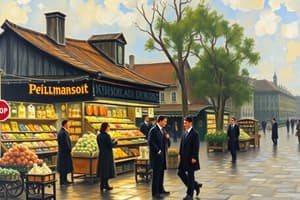Podcast
Questions and Answers
Commerce encompasses all aspects of trade, including the processes involved in the exchange of products and ______.
Commerce encompasses all aspects of trade, including the processes involved in the exchange of products and ______.
services
Internal trade refers to transactions within a ______.
Internal trade refers to transactions within a ______.
country
E-commerce specifically refers to buying and selling via the ______.
E-commerce specifically refers to buying and selling via the ______.
internet
B2B stands for transactions between ______.
B2B stands for transactions between ______.
The entire process of production and distribution of goods is known as the ______ chain.
The entire process of production and distribution of goods is known as the ______ chain.
Factors influencing commerce include economic environment, technological advancements, and social and cultural ______.
Factors influencing commerce include economic environment, technological advancements, and social and cultural ______.
Challenges in commerce include globalization, cybersecurity threats in ______, and supply chain disruptions.
Challenges in commerce include globalization, cybersecurity threats in ______, and supply chain disruptions.
Future trends in commerce indicate an increasing reliance on digital platforms and the growth of sustainable and ethical ______ practices.
Future trends in commerce indicate an increasing reliance on digital platforms and the growth of sustainable and ethical ______ practices.
Flashcards are hidden until you start studying
Study Notes
Definition of Commerce
- Commerce refers to the activity of buying and selling goods and services.
- It encompasses all aspects of trade, including the processes involved in the exchange of products and services.
Components of Commerce
-
Trade
- Internal Trade: Transactions within a country.
- External Trade: International transactions between countries.
-
Business Activities
- Involves production, distribution, and consumption of goods and services.
-
Services
- Non-tangible products offered to consumers, including banking, insurance, and consultancy.
Types of Commerce
- E-commerce: Buying and selling via the internet.
- M-commerce: Mobile commerce, transactions through mobile devices.
- B2B (Business to Business): Transactions between businesses.
- B2C (Business to Consumer): Transactions between businesses and consumers.
- C2C (Consumer to Consumer): Transactions between consumers, often facilitated by platforms.
Importance of Commerce
- Drives economic growth and development.
- Facilitates trade and investment.
- Enhances consumer choice and availability of goods and services.
- Creates job opportunities and supports livelihoods.
Key Concepts
- Supply Chain: The entire process of production and distribution of goods.
- Market: A place or system where buyers and sellers interact.
- Competition: The rivalry among businesses to attract customers.
- Consumer Behavior: The study of how individuals make decisions to spend their available resources.
Factors Influencing Commerce
- Economic environment (inflation, employment rates).
- Technological advancements (e.g., online payment systems).
- Regulatory framework (laws governing trade).
- Social and cultural trends (shifts in consumer preferences).
Challenges in Commerce
- Globalization and competition from international markets.
- Cybersecurity threats in e-commerce.
- Supply chain disruptions.
- Regulatory compliance and changes in trade policies.
Future Trends
- Increasing reliance on digital platforms for commerce.
- Growth of sustainable and ethical business practices.
- Rise of artificial intelligence and automation in commerce operations.
Definition of Commerce
- Commerce is the activity centered on buying and selling goods and services.
- Encompasses processes involved in the exchange of products and services.
Components of Commerce
- Trade: Divided into internal trade (transactions within a country) and external trade (international transactions).
- Business Activities: Includes production, distribution, and consumption of various goods and services.
- Services: Non-tangible offerings such as banking, insurance, and consulting provided to consumers.
Types of Commerce
- E-commerce: Conduct of buying and selling activities over the internet.
- M-commerce: Transactions executed through mobile devices.
- B2B (Business to Business): Business transactions between entities.
- B2C (Business to Consumer): Commercial transactions directly between businesses and individual consumers.
- C2C (Consumer to Consumer): Transactions among consumers facilitated by digital platforms.
Importance of Commerce
- Acts as a catalyst for economic growth and overall development.
- Enhances trade and investment opportunities.
- Improves consumer choice and the availability of goods and services.
- Generates job opportunities and aids in supporting livelihoods.
Key Concepts
- Supply Chain: The comprehensive journey of production to distribution of goods.
- Market: A system or location where buyers and sellers engage in transactions.
- Competition: The contest among businesses to acquire customers.
- Consumer Behavior: Analysis of how individuals decide to allocate their resources for purchases.
Factors Influencing Commerce
- Economic factors such as inflation and employment rates.
- Technological advancements, including the evolution of online payment systems.
- Regulatory frameworks shaping trade through laws and regulations.
- Social and cultural trends reflecting changes in consumer preferences.
Challenges in Commerce
- Increased globalization leading to competition from international markets.
- Cybersecurity risks threatening e-commerce transactions.
- Disruptions in supply chains impacting product availability.
- Compliance with fluctuating regulatory standards and trade policies.
Future Trends
- Greater reliance on digital platforms for conducting commerce activities.
- Enhanced focus on sustainable and ethical practices in business operations.
- Rising implementation of artificial intelligence and automation improving commerce efficiency.
Studying That Suits You
Use AI to generate personalized quizzes and flashcards to suit your learning preferences.




